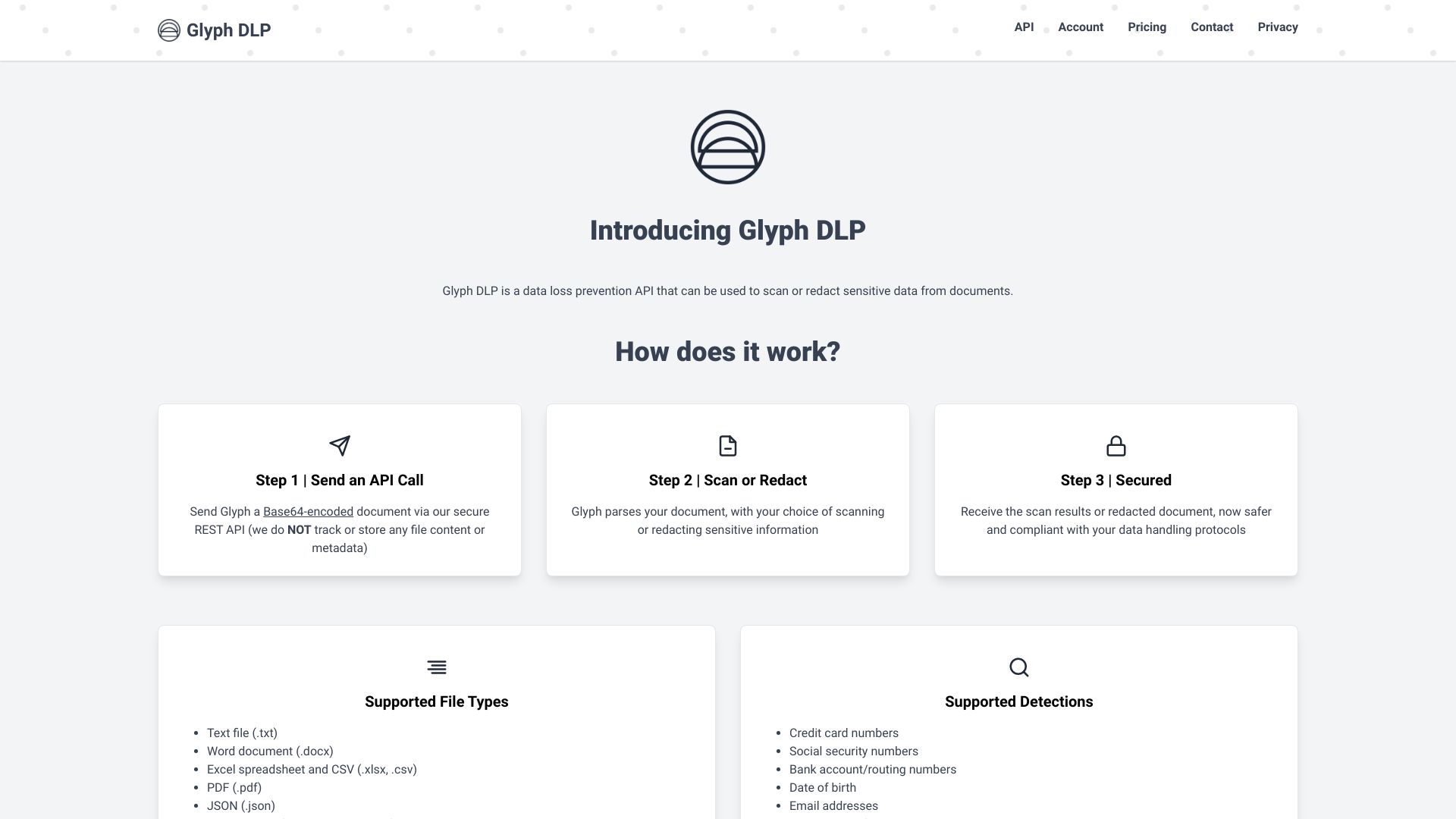```It looks like you are sharing information about Glyph DLP (Data Loss Prevention) and its usage along with some of its core features. Here's a concise summary of how to use Glyph DLP based on the steps mentioned:
### How to Use Glyph DLP
1. **Send an API Call**:
- Prepare your document and encode it in Base64 format.
- Use the secure REST API to send the encoded document.
2. **Scan or Redact**:
- Decide whether you want to scan the document for sensitive information or redact it.
- Execute the appropriate action through the API.
3. **Receive Results**:
- After processing, you will receive either the scan results or a redacted version of the document, ensuring that it adheres to your data handling protocols.
### Core Features of Glyph DLP
- **Data Loss Prevention API**: It allows you to scan documents and identify sensitive data.
- **Scanning and Redacting Sensitive Data**: This feature ensures that any sensitive information is either flagged or removed from documents, helping to maintain compliance and data security.
If you have further questions or need more specific information about Glyph DLP, feel free to ask!It seems like you're working with some HTML code related to a web page about Glyph DLP (Data Loss Prevention). The content includes sections on its use cases and a FAQ. Here’s a breakdown of what you have so far:
### Use Cases Section
- **Title**: Glyph DLP's Use Cases
- **First Use Case**:
- **Number**: #1
- **Description**: Safeguarding sensitive information, Protecting data privacy
### FAQ Section
- **Title**: FAQ from Glyph DLP
- The FAQ section seems to be set up with a definition list format, but the content isn't fully visible in the snippet you've provided.
If you need help with further development of this content, such as adding more use cases, FAQs, or styling suggestions, feel free to ask!It appears that you've pasted a snippet of HTML code, potentially from a web page, that includes a question about "Glyph DLP." The HTML includes styling and structure for a frequently asked question (FAQ) format, featuring an expandable section.
In this context, "Glyph DLP" likely refers to a Data Loss Prevention (DLP) solution or tool, possibly related to the Glyph brand. DLP solutions are designed to protect sensitive data from being lost, misused, or accessed by unauthorized users. They monitor and control data transfer across various channels and devices to prevent data breaches.
If you would like more specific information about Glyph DLP, please provide additional context or clarify what particular aspects you are interested in!It seems you are referencing a snippet of HTML code that contains information about Glyph DLP (Data Loss Prevention). However, the content is incomplete and lacks specific details about how Glyph DLP works and the file types it supports.
### How Glyph DLP Works
Glyph DLP is designed to protect sensitive data from being lost, misused, or accessed by unauthorized individuals. It typically operates by:
1. **Data Discovery**: Identifying and classifying sensitive data across various endpoints, servers, and cloud environments.
2. **Monitoring**: Continuously monitoring data in use, data at rest, and data in motion to detect potential data breaches or unauthorized access attempts.
3. **Policy Enforcement**: Implementing predefined security policies that control how sensitive data can be accessed, shared, or transmitted. This may involve restricting access to certain users or applications.
4. **Alerts and Reporting**: Generating alerts when policy violations occur and providing detailed reports for compliance and auditing purposes.
5. **Data Encryption**: Encrypting sensitive data to ensure that even if it is intercepted, it cannot be accessed without the proper decryption keys.
### File Types Supported by Glyph DLP
DLP solutions like Glyph typically support a wide range of file types, including but not limited to:
- Document formats (e.g., PDF, DOCX, XLSX)
- Image formats (e.g., JPEG, PNG, TIFF)
- Text files (e.g., TXT, CSV)
- Email formats (e.g., EML, MSG)
- Archive formats (e.g., ZIP, RAR)
- Multimedia files (e.g., MP4, MP3)
For the most accurate and detailed information on Glyph DLP's functionalities and supported file types, you should refer to the official documentation or product specifications from the provider.It looks like you've pasted a snippet of HTML and SVG code, possibly from a web page that discusses Glyph DLP (Data Loss Prevention). The code includes an SVG icon and a heading asking "What can Glyph DLP detect?"
If you need information about Glyph DLP and its detection capabilities, here is a brief overview:
**Glyph DLP Detection Capabilities:**
Glyph DLP can typically detect various types of sensitive data and potential data breaches, including but not limited to:
1. **Personal Identifiable Information (PII):** Such as names, addresses, Social Security numbers, and financial information.
2. **Intellectual Property (IP):** Including proprietary data, trade secrets, and confidential business information.
3. **Regulated Data:** Such as healthcare information (HIPAA), payment card information (PCI-DSS), and other industry-specific regulations.
4. **Data Movement:** Monitoring and controlling how data is transferred, accessed, or shared within and outside the organization.
If you have any specific questions or require further details, feel free to ask!It looks like you've shared a snippet of SVG (Scalable Vector Graphics) code, which is often used in web design for creating vector images. The attributes `stroke-linecap="round"` and `stroke-linejoin="round"` are used to define the appearance of the lines in the SVG.
- **`stroke-linecap="round"`**: This makes the ends of the strokes round rather than flat or squared off.
- **`stroke-linejoin="round"`**: This makes the corners where two lines meet rounded instead of sharp.
If you need help with SVG graphics or have a specific question related to this code, please let me kn
